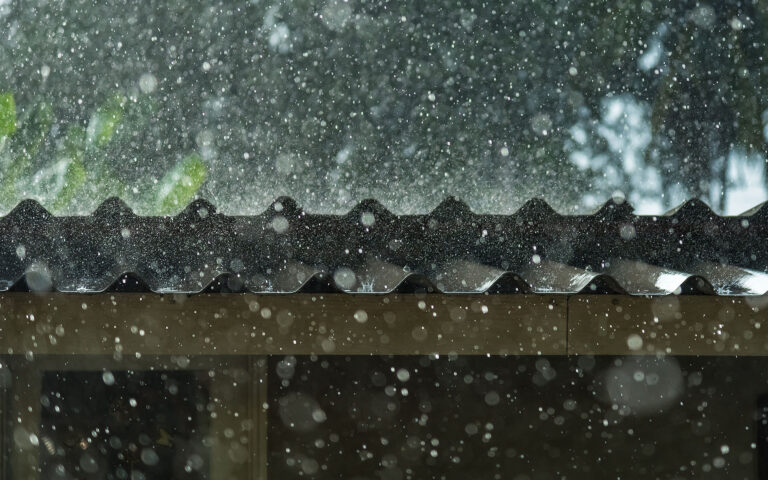Are you a professional roofer?
Most homeowners aren’t. But that doesn’t mean you can’t be prepared when it comes to emergency roof repair!
Having a basic plan in place can help you handle an emergency repair to your roof with ease and reduce feelings of panic. In today’s blog, we’ll help you to understand:
- What roof damage looks like
- When to call a professional
- How to care for it yourself
Keep reading to learn how to make emergency repairs and keep your roof functioning for years to come!
6 Signs of Roof Damage

Before you can address emergency roof repair, it’s essential to know how to spot the signs of damage. Detecting roof problems early can make a significant difference in preventing extensive and costly repairs. Here are some common signs to watch for:
1) Water Leaks
Water leaks are one of the most obvious – and serious – signs of roof damage. It can present as:
- Water stains on your ceiling or walls.
- Dripping water or moisture inside your home, especially during rain.
2) Missing or Damaged Shingles
One or two missing or damaged shingles may not seem like a roof repair emergency, but even a single damaged shingle can allow water to seep through!
- Check for shingles that are cracked, curled, or missing.
- Look for granules from shingles in your gutters or around your property.
3) Sagging or Uneven Roof
It’s never a good sign if you notice your roof sagging. If you suspect that your roof is sagging or bowing, we recommend contacting roofing contractors as soon as possible.
- Visually inspect your roof for any noticeable sagging.
- Use binoculars to check for any uneven areas.
4) Clogged Gutters
Many homeowners don’t realize the damage to your roof that clogged gutters can cause. But if water can’t flow off your roof properly, it can settle and create water damage.
- Accumulation of debris in your gutters can lead to water damage and roof issues.
- Regularly clean your gutters to prevent problems.
5) Mold or Algae Growth
It’s not uncommon for roofs to develop algae and mold growth after being exposed to water, but it can create a huge problem for you!
- Moss, algae, or mold can grow on your roof’s surface, indicating excess moisture.
- Address this issue promptly to prevent further damage.
6) Interior Signs
Sometimes, you’ll find that the most visible signs of roof damage can be found inside of your home instead of outside of it, including:
- Peeling paint or wallpaper.
- Musty odors in your attic or home.
- Water stains on the walls and ceilings
5 Steps to Take When You Notice Roof Damage

When you notice any signs of roof damage, it’s crucial to take immediate action to prevent further deterioration. Follow these steps to address the situation effectively:
1) Safety First
- Ensure your safety by avoiding climbing onto your roof if it’s slippery or during adverse weather conditions.
- Use proper safety equipment, such as a sturdy ladder and appropriate footwear.
2) Document the Damage
- Take photos or videos of the damage for insurance claims and future reference.
3) Temporary Measures
- If you notice a leak, place buckets or containers under the affected area to collect water and minimize interior damage.
- Use tarps or plastic sheets to cover the damaged section temporarily.
4) Clear Debris
- Safely remove any debris, branches, or foreign objects from your roof to prevent further damage.
- Be cautious not to cause more harm during the cleaning process.
5) Inspect Your Attic
- Check your attic for signs of water infiltration, such as wet insulation or water stains.
- Address any interior damage promptly to avoid structural issues.
How to Do an Emergency Roof Repair
If you’re confident in your DIY skills and the damage is minimal, you can attempt an emergency roof repair yourself. Keep in mind that these are temporary solutions, and it’s crucial to consult a professional roofer for a permanent fix. Here’s a step-by-step guide:
Gather Materials 🧰
You’ll need roofing cement, roofing nails, a hammer, a putty knife, and replacement shingles (if applicable).
Secure Loose Shingles 🔨
Lift the damaged shingle and apply roofing cement underneath. Press the shingle down and nail it in place with roofing nails.
Patch Small Holes ⚒️
If you have small holes or cracks, apply roofing cement over them. Smooth it out with a putty knife and allow it to dry.
Replace Missing Shingles 🔎
If you have missing shingles, slide a new one into place and secure it with roofing nails. Apply roofing cement over the nails for added protection.
Seal Flashings 👍
Check your roof’s flashings (the metal strips around chimneys, vents, and skylights). Seal any gaps or cracks with roofing cement.
Cover with Tarp 👷🏾
If the damage is extensive or you can’t complete repairs, cover the affected area with a tarp. Secure the tarp with boards or heavy objects to prevent it from blowing away.
When to Call in a Professional Roofer

While DIY repairs can be a temporary solution, they may not address the root cause of the problem. Here are some situations in which it’s best to call in a professional roofer:
- Extensive Damage: If your roof is severely damaged or has multiple problem areas, it’s time to consult a professional. Professionals have the expertise to assess the extent of damage and provide appropriate solutions.
- Safety Concerns: If your roof is steep or slippery, attempting repairs yourself can be dangerous.
- Warranty Preservation: If your roof is under warranty, DIY repairs may void it.
- Uncertain Diagnosis: If you’re unsure of the root cause of the problem, it’s best to consult a roofer. They can identify underlying issues that may not be apparent to an untrained eye.
- Preventive Maintenance: Regular roof inspections by professionals can help identify potential issues before they become emergencies.
Roofing Contractors You Can Trust
When it is time to call in the pros at a moment’s notice, you need a team you can rely on. Tectum Roofing makes that easy, with a knowledgeable team of roofers ready to tackle any emergency situation you find yourself in. Contact us today for an estimate on your roofing project!




